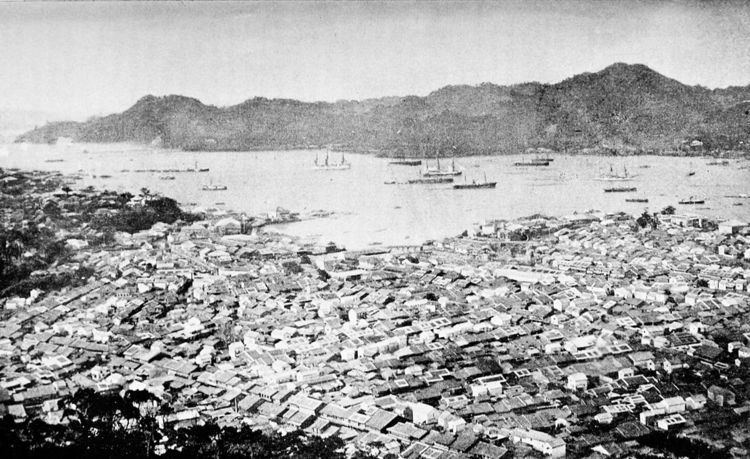Dates 13 Aug 1886 – 15 Aug 1886 | ||
 | ||
The Nagasaki incident (長崎事件, Nagasaki Jiken), also known as the Nagasaki―Qing Navy Incident (長崎清国水兵事件), was a riot involving Chinese Beiyang Fleet sailors in Nagasaki.
Contents
Outline
On 1 August 1886 (Meiji 19), the Qing Dynasty's navy called the Beiyang Fleet, the four warships, the Dingyuan (定遠), the Zhenyuan (鎮遠), the Jiyuan (濟遠), and Weiyuan (威遠), entered the Nagasaki harbor port during a visit to various major Asian harbours. At that time, China (Qing Dynasty) was much stronger than Japan. The Dingyuan was a heavier ship than the heaviest Japanese cruisers. In addition, Japan had suffered a setback during the Gapsin Coup in which 400 Japanese soldiers were defeated by 2000 Qing soldiers.
On August 13, 500 Chinese troops took part in shore leave. They went to the red-light district, where during an altercation with locals, damanged fixtured were blamed on the visitors. Local also claimed that drunken Chinese soldiers went around the city pursuing women and children, causing outrages. Nagasaki Prefecture Police Department tried to intervene together with a large number of local civilians. As a result, the policemen and Chinese soldiers began to fight hand-to-hand in sword battles within the city. There were at least 80 deaths on both sides, and the soldiers were arrested. They used swords purchased from stores. As a result, a sense of unrest thus pervaded.
On August 14, at a conference between the governor of Nagasaki prefecture, Kusaka Yoshio, and the Qing consulate Xuan Cai, the Qing navy prohibited its soldiers from going on land as a group for one day, and agreed that when soldiers are on leave, they would be overseen by an officer.
On August 15 at around 1 PM about 300 Chinese troops went ashore, following the cessation of the agreement. Some were armed with clubs. Several Chinese urinated on a Kōban (交番 kōban), police box. Some Chinese sailors attacked three police officers, resulting in one death. A driver of a rickshaw (jinrikisha) who saw this was indignant about this, and tried to punch a Chinese sailor with his fist. In response, the Chinese sailors began a riot. Thus, another big incident began as the policemen who came to stop this and the Chinese sailors once again began fighting, with various casualties (On the Qing side, 1 officer died and 3 were injured, and 3 soldiers died and at least 50 were injured. On the Japanese side, 3 police officers were injured, 2 constables died, and 16 were injured. Several tens of Japanese civilians were also injured).
Effects of the incident
Combined with the Gapsin coup of 1884 (Meiji 17), this incident stirred up anti-Qing sentiment and was a distant cause to the First Sino-Japanese War. Also, Toyoma Mitsuru created the political association called the Genyosha, which was the first turning away from civil rights theory to sovereign rights theory.
After the incident, the Qing did not apologize to Japan, and behaved with confidence believing in the superiority of their navy. At that time, the Qing possessed the newest model of navy battleships, the Dingyuan. It was thought that the Japanese navy could not match this ship at this time, having a heavier tonnage than modern French built Japanese cruisers. (The Dingyuan was eventually scuttled after the Battle of Weihaiwei in 1895.) Japan's setback during the Gapsin Coup, in which 400 Japanese soldiers had been driven off by 2000 Qing soldiers was still recent and fresh.
The Qing made demands to the Japanese government that from then on the Japanese police would not prohibit the wielding of swords, in which they succeeded. However, as a result of this incident, anti-Qing sentiment rose in Japan, presaging further confrontation.
In addition, the event also produced another consequence: the cracking of the Qing intelligence code. A Japanese man named Wu Oogoro picked up a Beiyang Navy sailor's dictionary which was marked with 0-9 between the Chinese characters (Kanji). The Japanese intelligence department subsequently analysed these characters and figures and determined it was a guide to decipher the Qing codes. In order to completely crack the code, Japanese Foreign Minister Mutsu Munemitsu deliberately provided a writing in Chinese characters of the moderate length to the Qing ambassador Wang Feng Cao. The next day the Japan Telecom legation successfully intercepted the telegram sent by the embassy to Zongli Yamen. Sato Yoshimaro, a bureaucrat in the telecom legation used this kanji text with known content to crack the Qing code. This had effects similar to the cracking of the Enigma and handed Japan an advantage in the First Sino-Japanese war.
